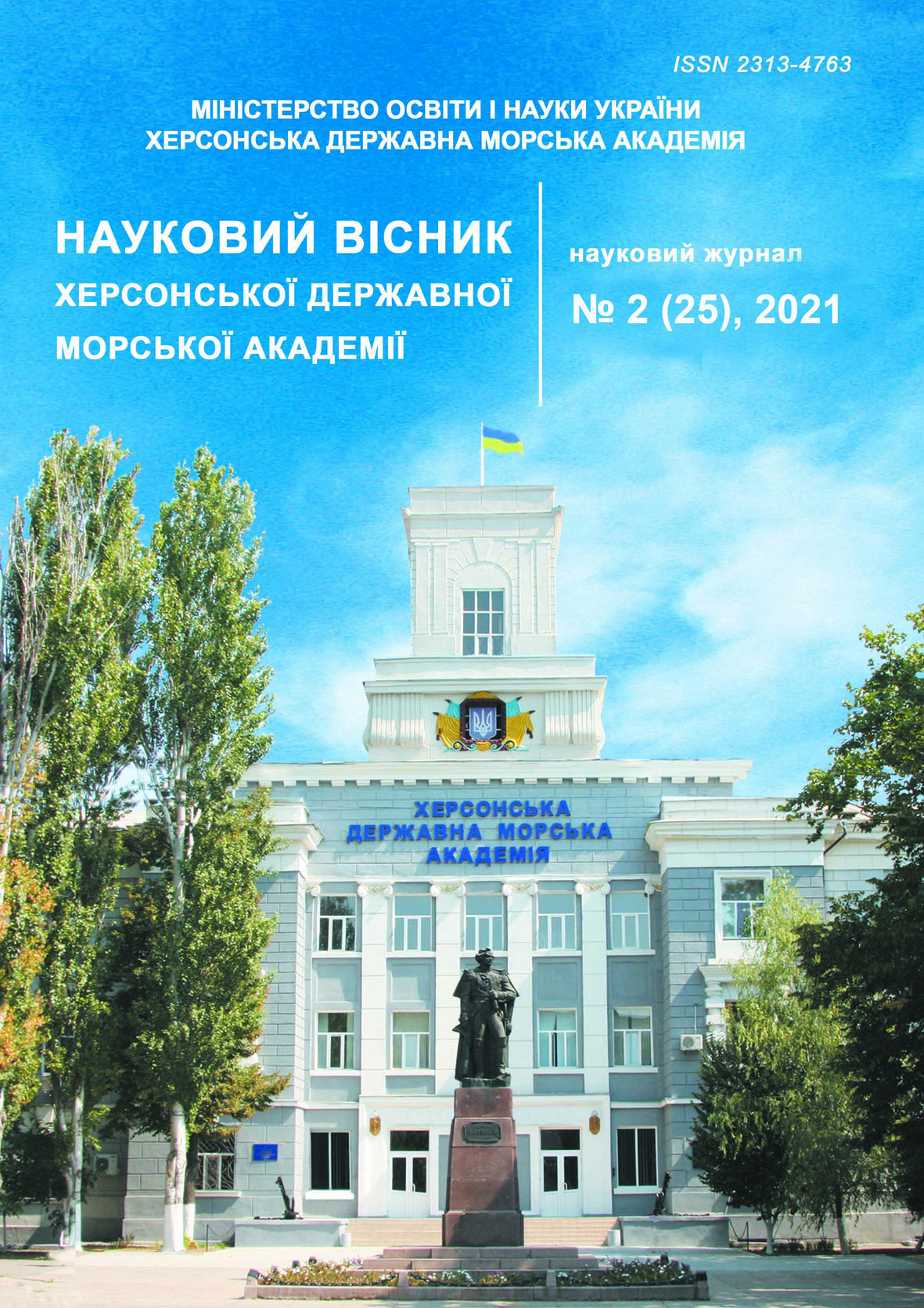THE NEWEST POLYMER MATERIALS FOR ANTI-CORROSION PROTECTION OF THE SURFACES OF SHIP CARGO AND DECK MECHANISMS
10.33815/2313-4763.2021.2.25.048-058
Abstract
Epoxy diane oligomer of ED-20 brand and polyethylene polyamine PEPA hardener were used for the formation of composite materials and protective coatings on their bases. The choice of dispersed fillers is due to the presence of active groups on their surface, a set of improved characteristics of the components, which is of scientific and practical interest in the use of additives for the formation of protective coatings. The optimal content of various additives in the epoxy binder ED-20 was determined by mathematical planning using the application package STATGRAPHICS® Centurion XVI. This allowed us to predict and obtain an epoxy coating with a set of improved properties. It was found that the composite material of the following composition are characterized by improved physical and mechanical properties: a mixture of discrete organic fibers – q = 0.025 wt%, anti-agglomerating additive hydropho biervnsmittel – q = 20 wt%. per 100 wt%. by weight oligomer ED-20 and 10 wt% firm PEPA. Such epoxy composite material are characterized by the following properties: destructive bending stres – σst = 92.6 MPa, flexural modulus – E = 5.6 GPa. Based on the mathematical planning of the experiment, the variants of coatings that were tested for corrosion resistance were determined. The analysis of changes in resistivity and specific capacity of coatings for 30 days under the influence of various aggressive media (sulfuric acid and river water) at a temperature of T = 293 ± 2 K. It is established that the composite material containing: epoxy oligomer ED-20 (100 wt%), CDOW (0.025 wt%), HDBS (20 wt%), hardener polyethylene polyamine PEPA (10 wt%) due to the formation of a diffusion barrier in the volume of the protective coating is characterized by the highest the value of resistivity and the lowest value of specific capacity in all aggressive environments. This indicates improved anti-corrosion properties of the coating. Visual analysis of defects, which was carried out in natural conditions under the influence of river water and variable temperatures in the range ΔT = (258… 298) ± 2 K for τ = 250 days allowed to confirm previous experimental studies and to determine coatings with improved anticorrosive properties.
References
2. Dolgov, M. A., Zubrets’ka, N. A., Buketov, A. V., and Stukhlyak, P. D., Use of the Method of Mathematical Experiment Planning for Evaluating Adhesive Strength of Protective Coatings Modified by Energy Fields, Strength Mater. 2012. vol. 44, no. 1. pp. 81–86.
3. Smetankin, S. O., Nigalatij, V. D., Buketov, A. V., Sharko, O. V., Sky`rdenko, O. I., Baglyuk, G. A. Rozrobka mody`fikovany`x polimerny`x kompozy`tiv dlya remontu detalej energety`chny`x ustanovok transportny`x sy`stem. Naukovy`j visny`k Xersons`koyi derzhavnoyi mors`koyi akademiyi. 2016. Vy`pusk 1. S. 252–261.
4. Buketov А. V., Sapronov О. О., Brailo М. V. Investigation of the Physico-Mechanical and Thermophysical Properties of Epoxy Composites with a Two-Component Bidisperse Filler. Strength of Materials. 2014. Vol. 46, No 5. pp.717–723. doi: 10.1007/s11223-014-9605-z.
5. Sapronov O. O. Pidvy`shhennya anty`korozijny`x xaraktery`sty`k detalej sudnovy`x energety`chny`x ustanovok za raxunok vy`kory`stannya epoksy`kompozy`tny`x pokry`ttiv. Naukovi notatky`. 2014. Vy`pusk 47. S. 176–181.
6. Elmore J. D., Kincaid D. S., Komar P. C., Nielsen, J. E. Waterborne epoxy protective coatings for metal. Journal of Coatings Technology. 2002. 74(8). рр. 63–72. doi:10.1007/bf02697969.
7. Buketov A. V., Sapronova A. V., Sapronov O. O., Buketova N. M., Sotsenko V. V., Brailo M. V., Yakushchenko S. V., Maruschak P. O., Panin S. V., Smetankin S. O., Kulinich A. G., Kulinich V. G. Influence of the structure of epoxy composite filled with discrete fibers on impact fracture of vehicle parts. Composites: Mechanics, Computations, Applications: An International Journal. 2020. Vol. 11. № 2. pp. 113–127. doi: 10.1615/CompMech ComputApplIntJ.2020031192).
8. Yacy`shy`n O. I., Chervins`ky`j T. I., Braty`chak M. M. Vy`vchennya strukturuvannya epoksy`dnoyi smoly` ED-20 u pry`sutnosti reakcijnozdatny`x oligomeriv. Visny`k L`vivs`koyi politexniky`. Ximiya, texnologiya rechovy`n ta yix zastosuvannya. 2012. # 726. S. 467–471.
9. Buketov A. V., Sapronova A. V., Braila M. V., Sotsenko V. V., Yurenin K. Yu., Antonio B. Polymer composites for improving the resource of pipeline transport. Journal of Hydrocarbon Power Engineering. 2018. Vol. 5(2). P. 43–49.
10. Sapronova A. V. Vply`v vmistu organichny`x volokon u epoksy`dnomu zv'yazuvachi na pokazny`ky` adgezijnoyi ta kogezijnoyi micznosti pokry`ttiv transportnoyi texniky`. Naukovy`j visny`k XDMA. 2019. #1(20). S. 141–151.
11. Brayilo M. V., Brayilo M. V., Buketov A. V., Yakushhenko S. V., Dulebova L. Zastosuvannya metodu planuvannya ekspery`mentu pry` formuvanni polimernogo kompozy`tu z polipsheny`my` ekspluatacijny`my` xaraktery`sty`kamy` dlya jogo vy`kory`stannya u zasobax transportu. Naukovi notatky`. Vy`pusk 60. 2017. S. 58–68.
12. Buketov A. V., Aky`mov A. V., Ny`galaty`j V. D., Bray`lo N. V., Al`-Dzhavaxery` Aly` Andan Mansur. Pry`meneny`e metodov matematy`cheskoj staty`sty`ky` dlya opty`my`zacy`y` sostava zashhy`tnыx pokrыty`j. Vestny`k Karagandy`nskogo gosudarstvennogo uny`versy`teta. 2017. #1 (85). S. 17–27.
13. Brayilo M. V., Yakushhenko S. V., Kobel`ny`k O. S., Buketova N. M., Voronenko S. V. Stvorennya nanonapovneny`x epoksy`-poliefirny`x kompozy`tny`x materialiv dlya zaxy`stu elementiv sudnovy`x texnichny`x zasobiv. Naukovy`j visny`k Xersons`koyi derzhavnoyi mors`koyi akademiyi. 2020. # 1 (22). S. 136–144.
14. Brayilo M. V., Yakushhenko S. V., Fesenko I. P. Opty`mizaciya vmistu iniciatora u poliefirnij matry`ci za yiyi fizy`ko-mexanichny`my` vlasty`vostyamy`. Naukovi notatky`. 2017. Vy`pusk 57. S. 32–36.
15. Zaxarov N. M., Alushky`na T. V. Opty`my`zacy`ya sostava zashhy`tnыx pokrыty`j na osnove эpoksy`dnыx smol. Эlektronnыj nauchnыj zhurnal «Neftegazovoe obrashheny`ya». 2009.
16. Buketov, A. V., Gusyev, V. M., Kulinich, A. G., Yakushhenko, S. V., Zhy`tny`k, D. V.: Opty`mizaciya vmistu ingrediyentiv pry` formuvanni zaxy`sny`x pokry`ttiv dlya pidvy`shhennya resursu roboty` transportny`x zasobiv. Naukovy`j visny`k XDMA. 2020. 2 (23). S. 58–67.






